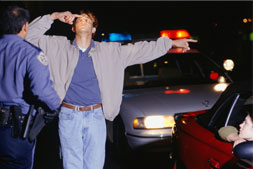When a police officer pulls over a driver or stops a driver at a DUI checkpoint because the officer suspects that the driver may be driving under the influence of drugs or alcohol, the officer will more than likely request that the suspect driver participate in a series of tests commonly referred to as field sobriety tests. In Massachusetts, you have the right to refuse to participate in these tests.
There are Three Standardized Field Sobriety Tests
Developed by the National Highway Traffic Safety Administration (NHTSA), field sobriety testing include three different tests that are designed to present indicators of whether the test participant is intoxicated by drugs or alcohol. These tests challenge an individual’s coordination, ability to follow instructions, and balance, and also evaluate involuntary eye movements. The NHTSA has conducted research on each of these tests and determined how accurate each test is for determining whether the test taking participant is legally intoxicated, i.e., that he or she has a blood alcohol content that exceeds 0.08%.
- Horizontal Gaze Nystagmus. The horizontal gaze nystagmus (HGN) test identifies involuntary eye movements of the suspected drunk driver. As part of the test, a law enforcement officer observes an intoxicated suspect’s eyes while the suspect tracks an object, such as a pen or a small flashlight. An intoxicated person is not able to smoothly track the object and will exhibit small jerky eye movements. The HGN test is based on what the officer observes, and is considered by the NHTSA to be accurate at determining if a suspect has a blood alcohol content that is over the legal limit 88 percent of the time.
- Walk-and-Turn. The walk-and-turn (WAT) test requires the suspect to walk back and forth 9 steps in a straight line, turn and return in the same way. The steps must be taken heel-to-toe, and the turn must be conducted on only one leg. Not only does this test require coordination, balance and focus, but it also requires the suspect to follow specific instructions, which also tests memory. The NHTSA’s research has indicated that the WAT test is only accurate 79 percent of the time.
- One Leg Stand. As the name implies, the one leg stand (OLS) test requires a suspect to stand on one leg. The suspect must raise one foot six inches off the ground and maintain his or her balance for half a minute. The NHTSA has indicated that the OLS test is accurate about 83 percent of the time.
Contacting a Massachusetts Criminal Defense Attorney
 Massachusetts Criminal Defense Attorney Blog
Massachusetts Criminal Defense Attorney Blog


